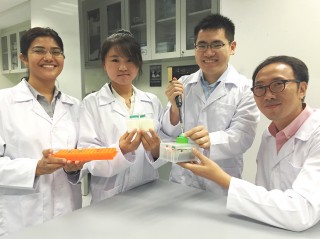NUS Researchers Developed World’s First Instant Fluorescent Sensor to Detect Milk Fat

National University of Singapore A team of NUS researchers, led by Prof Chang Young-Tae, has developed the world’s first fluorescent sensor – called Milk Orange – that rapidly identifies the presence of fat in milk.
A team of researchers from the National University of Singapore (NUS) has pioneered the world’s first fluorescent sensor – called Milk Orange – that rapidly identifies the presence of fat in milk. When the light purplish sensor is mixed with a milk sample, it transmits fluorescent signals of orange hues instantly under light when fat is detected, with brighter shades when the concentration of fat in the milk sample increases.
This novel sensor, developed by a research team led by Professor Chang Young-Tae of the Department of Chemistry at the NUS Faculty of Science, is being applied to the development of a device for rapid on-site measurement of milk fat, which is especially useful in areas such as dairy farms in developing countries. This device could also help enhance the current milk quality control process, particularly in resource-limited regions.
The findings of this study were first published in the journal Chemical Communications on 8 July 2014.
Measuring milk fat and quality
More than six billion people around the world consume milk regularly, making milk a major agricultural product in many countries. It is also a multi-billion dollar industry. As fat content is associated with the levels of protein and vitamins in milk, it is directly correlated with the nutritional and marketing value of milk.
For many small scale dairy farmers who sell their cows’ milk to large organisations that produce dairy products, there is a need for an accurate and rapid device which is handy yet inexpensive, to detect the level of fat present in the milk. Such a device helps the farmers segregate and price the milk for sale, as well as to enhance the milk quality control process.
Prevailing milk fat measurement methods include infrared analysis, lactometers, and Gerber’s method. Infrared methods are very complex and expensive, but extremely fast. Lactometers are simple and economical, but do not reveal the exact amount of fat. Gerber’s method, on the other hand, provides accurate readings, but requires complicated handling due to the use corrosive sulfuric acid, making it unfavourable for untrained workers.
To address this technological gap, the NUS research team sought to develop a method that is low-cost, easy to use and efficient.
Milk Orange: A novel fluorescent sensor to detect milk fat
Fluorescent dyes have been widely used as sensors for analytical purposes because of their high sensitivity, fast response time and technical simplicity.
Under the supervision of Prof Chang, the research team screened more than 10,000 fluorescent dyes that are part of the Diversity Oriented Fluorescence Library (DOFL), which was developed by Prof Chang over the last decade.
The researchers successfully identified a light purplish non-toxic compound which demonstrated remarkable fluorescence signal increments of orange hues with increasing concentrations of milk fat under light. The team conducted further experiments to ensure that the compound, coined Milk Orange, responds to fat, and not to other substances in milk such as proteins.
To explore Milk Orange’s applicability, the team tested it in various milk samples which are readily available in local supermarkets. A total of 16 types of milk from seven brands were tested. The experiments concluded that Milk Orange can be applied universally and achieve instant results.
Portable, convenient and inexpensive milk fat device to measure milk fat in the works
With Milk Orange proving to be efficient in detecting the level of fat in different types of milk, Prof Chang and his team are now developing a portable, convenient and inexpensive detector for rapid on-the-spot milk fat measurement. They are also planning to set-up a spin-off company to commercialise this technology. The team looks forward to working with milk production and processing companies to apply the technology towards improving the current milk quality control process.
Contact Information
Carolyn Fong
carolyn@nus.edu.sg
Phone: +65 6516 5399
Media Contact
All latest news from the category: Life Sciences and Chemistry
Articles and reports from the Life Sciences and chemistry area deal with applied and basic research into modern biology, chemistry and human medicine.
Valuable information can be found on a range of life sciences fields including bacteriology, biochemistry, bionics, bioinformatics, biophysics, biotechnology, genetics, geobotany, human biology, marine biology, microbiology, molecular biology, cellular biology, zoology, bioinorganic chemistry, microchemistry and environmental chemistry.
Newest articles

Octopus inspires new suction mechanism for robots
A new robotic suction cup which can grasp rough, curved and heavy stone, has been developed by scientists at the University of Bristol. The team, based at Bristol Robotics Laboratory,…

Peptides on Interstellar Ice
A research team led by Dr Serge Krasnokutski from the Astrophysics Laboratory at the Max Planck Institute for Astronomy at the University of Jena had already demonstrated that simple peptides…

A new look at the consequences of light pollution
GAME 2024 begins its experiments in eight countries. Can artificial light at night harm marine algae and impair their important functions for coastal ecosystems? This year’s project of the training…





















